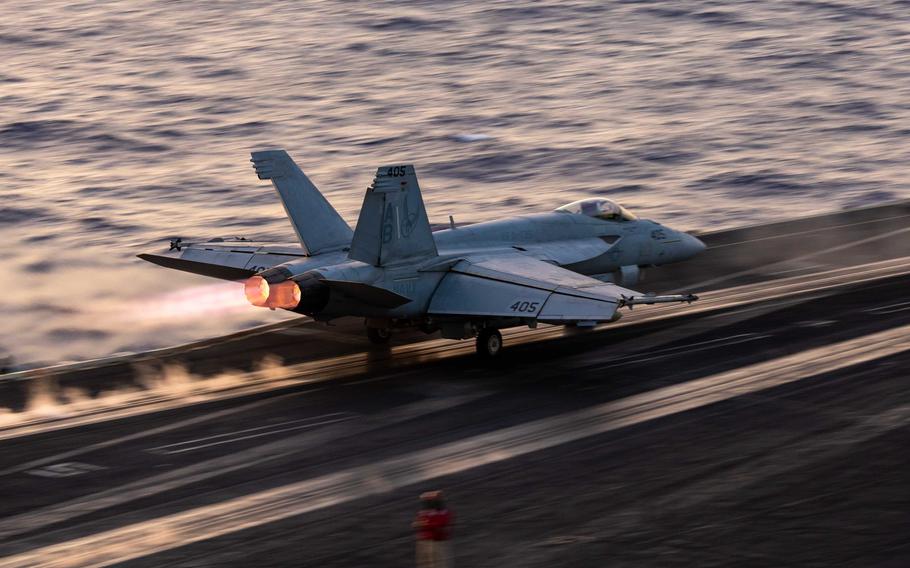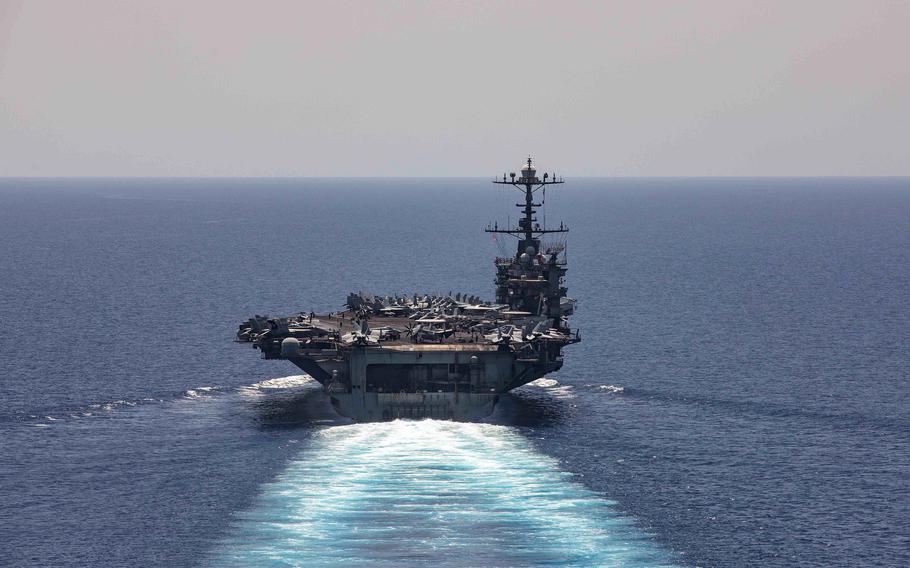
An F/A-18E Super Hornet launches from the aircraft carrier USS Harry S. Truman in the Red Sea on April 28, 2025. The Navy is investigating what caused a Super Hornet and a towing tractor to fall into the sea earlier this week. (Madelyn Cuevas/U.S. Navy)
A hard turn by an aircraft carrier isn’t enough on its own to cause a $67 million Navy fighter jet to slide off a ship, a Defense Department official said as investigators determine how a plane fell into the Red Sea on Monday.
The notion that a maneuver by USS Harry S. Truman was a factor in the loss is “speculative,” said the official, who spoke to Stars and Stripes on condition of anonymity because they were not authorized to speak publicly by name.
On Monday, the Navy said one person was slightly injured when the F/A-18E Super Hornet and a towing tractor moving the plane in a hangar bay fell overboard. The Navy didn’t specify the cause.
The next day, a Pentagon official speaking on background released a statement to media outlets indicating it happened “when the move crew lost control of the aircraft while the Truman was dynamically maneuvering.” A U.S. official told CNN the turn was taken to avoid enemy fire.
There is likely a broader explanation, the Defense Department official who spoke with Stars and Stripes on Wednesday and Thursday said.
“A ship at sea should not have aircraft slipping off it, regardless of the sea state … or maneuvering,” the official said.
The official pointed to Navy processes and procedures that account for turns, weather and other challenges in ensuring aircraft remain secure. An investigation will reveal the cause and any contributing factors, the official said.
Since March 15, Truman has been conducting daily flight operations as part of Operation Rough Rider, a U.S. effort to degrade the capabilities of the Iran-backed Houthis.
The Pentagon says U.S. forces have struck more than 1,000 targets, including multiple command and control facilities, air defense systems and weapons storage and production facilities.

The aircraft carrier USS Harry S. Truman sails in the U.S. Central Command area of responsibility April 8, 2025. The Navy is investigating what caused a Super Hornet and a towing tractor to fall into the sea earlier this week. (Kaitlin Young/U.S. Navy)
It’s unknown why Truman would have been steered in a way that could send a plane overboard.
“Evasive maneuvers against anti-ship missiles (ASM) are not a standard procedure and would not generally be relevant or effective given the great difference in speed between ASMs and ships,” said Jan van Tol, a retired Navy captain and senior fellow at the Center for Strategic and Budgetary Assessments in Washington.
An aircraft carrier would rely on escorting ships, its own fighters against some threats and/or its own passive defensive measures to provide its best defense, van Tol said in an email.
One of Truman’s escort ships, such as the cruiser USS Gettysburg, presumably would act as the carrier’s shotgun defense platform, ready at a moment’s notice to fire weapons at an incoming missile threat, said Steven Wills, an analyst with the Center for Maritime Strategy at the Navy League of the United States.
“One would think that we would have heard something about weapons being fired in self-defense by one of the carrier’s escorts in addition to hearing that the carrier maneuvered to avoid attack,” Wills said.
A sudden, hard turn at high speed could produce the type of list that could upset a trailer towing an aircraft near an elevator where it might fall off the ship, Wills and other analysts said.
Use of such a maneuver to help a nearby ship or an aircraft get a better shot at an incoming missile is plausible, said James Holmes, chair of the maritime strategy program at the Naval War College in Newport, R.I.
But there are other explanations, such as “a freak accident perhaps related to constant operations and crew fatigue,” Holmes said.
The loss of the Super Hornet is the third major incident involving Truman in about four months.
On Dec. 22, an F/A-18F launching from the deck of the carrier mistakenly was shot down by the cruiser USS Gettysburg, U.S. Central Command said at the time. Both aviators aboard the aircraft were recovered safely.
In February, Truman was involved in a collision with a commercial ship near the entrance to the Suez Canal, necessitating a nearly weeklong stay on the Greek island of Crete for repairs.
An analyst noted that Truman and its escort weren’t transmitting their location at the time of the late-night collision, as required when a Navy ship is in congested waters. Truman’s commanding officer was fired a little more than a week after the Feb. 12 collision.
Those incidents remain under investigation.
The Navy wouldn’t say whether it intends to recover the jet involved in the most recent mishap or whether the aircraft was equipped with upgrades, such as an infrared search-and-track system useful in pinpointing stealthy aircraft.
But keeping salvage units in place for a prolonged period in an area vulnerable to attack is probably not a good idea, van Tol said, adding that Super Hornets are older aircraft and not as much of a concern when it comes to potential foreign exploitation as the newer F-35 Lightning II.